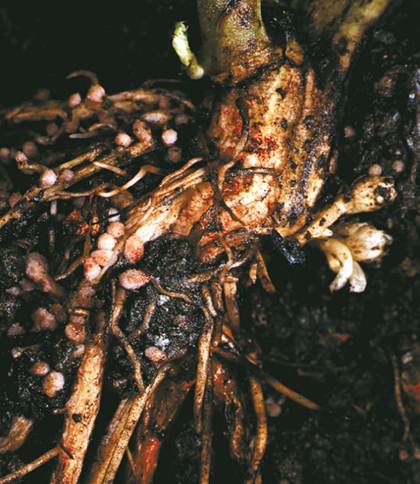


 النبات
النبات
 الحيوان
الحيوان
 الأحياء المجهرية
الأحياء المجهرية
 علم الأمراض
علم الأمراض
 التقانة الإحيائية
التقانة الإحيائية
 التقنية الحيوية المكروبية
التقنية الحيوية المكروبية
 التقنية الحياتية النانوية
التقنية الحياتية النانوية
 علم الأجنة
علم الأجنة
 الأحياء الجزيئي
الأحياء الجزيئي
 علم وظائف الأعضاء
علم وظائف الأعضاء
 الغدد
الغدد
 المضادات الحيوية
المضادات الحيوية|
Read More
Date: 28-12-2020
Date: 1-11-2015
Date: 13-10-2015
|
Nitrogen Fixation
Nitrogen fixation refers to the conversion of atmospheric nitrogen gas (N2) into a form usable by plants and other organisms. Nitrogen fixation is con-ducted by a variety of bacteria, both as free-living organisms and in symbiotic association with plants. Because it is the principal source of the nitrogen in the soil, nitrogen that plants need to grow, nitrogen fixation is one of the most important biochemical processes on Earth. Even modern agricultural systems depend on nitrogen fixation by alfalfa, clover, and other legumes to supplement chemical nitrogen fertilizers.
Living organisms need nitrogen because it is a part of the amino acids that make up proteins, and the nucleic acids that make up DNA (deoxyri-bonucleic acid) and RNA (ribonucleic acid). Nitrogen within living organ-isms is eventually decomposed and converted to atmospheric nitrogen (N2). This form, however, is highly stable and unreactive chemically, and is therefore not available for use by most organisms. Some species of bacteria, though, can convert N2 into NH3 (ammonia) or other usable forms of nitrogen. These nitrogen-fixing bacteria include species of the genera Rhizobium, Anabaena, Azotobacter, and Clostridium, as well as others.
Each of the nitrogen-fixing bacteria employs the same enzyme, nitro-genase. The nitrogenase enzyme is shaped something like a butterfly, and contains an atom of molybdenum at its core that is crucial for the reaction. Soils deficient in molybdenum cannot sustain effective nitrogen fixation, and monitoring soil for this element is important to ensure maximum fixation in managed fields or pastures.
Nitrogenase requires a large amount of energy to convert N2 to NH3. Free-living bacteria must obtain the nutrients for supplying this energy themselves. Other bacteria have developed symbiotic associations with plants to provide them with sugars, supplying both a source of energy and a source of carbon for the bacterium’s own synthetic reactions. The bacteria, in turn, supply the plant with some of the fixed nitrogen. For instance, the nitrogen-fixing Anabaena lives symbiotically with a water fern, Azolla. Azolla is grown in rice paddies early in the season. As the rice grows above the water surface, it shades out the fern, which dies, releasing the stored nitrogen. In this way, the paddy is fertilized without application of chemical fertilizers.
The bacterial genera Rhizobium and Bradyrhizobium have developed a large number of symbioses with members of the Fabaceae (legume) family. Fabaceae includes alfalfa, clover, beans and peas of all kinds, mesquites, acacias, and dozens of other species both domesticated and wild. The roots of the host plant become infected with the bacteria as seedlings, and respond by surrounding the bacteria with root hairs. The relationship between a particular host species and a particular bacterium is highly specific, and is regulated by a series of recognition events that prevent the wrong species of bacterium from taking up residence in the wrong plant.

Nitrogen-fixing bacteria Rhizobium on the roots of the broad bean plant Vicia faba.
The plant eventually develops a specialized structure known as a nodule, while the bacteria inside grow into enlarged forms known as bacteroids. The oxygen concentration inside the nodule must be closely regulated, since oxygen inhibits nitrogenase. This regulation is aided by the presence of leghemoglobin, an oxygen-binding protein similar to hemoglobin. The heme (oxygen-binding) portion is produced by the bacterium, while the globin (protein) portion is produced by the host plant, again illustrating the closeness of the symbiotic relationship.
Referencesٌ
Raven, Peter H., Ray F. Evert, and Susan E. Eichhorn. Biology of Plants, 6th ed. New York: W. H. Freeman and Company, 1999.



|
|
|
|
إجراء أول اختبار لدواء "ثوري" يتصدى لعدة أنواع من السرطان
|
|
|
|
|
|
|
دراسة تكشف "سببا غريبا" يعيق نمو الطيور
|
|
|
|
|
|
قسم الشؤون الفكرية يقيم برنامج (صنّاع المحتوى الهادف) لوفدٍ من محافظة ذي قار
|
|
|
|
الهيأة العليا لإحياء التراث تنظّم ورشة عن تحقيق المخطوطات الناقصة
|
|
|
|
قسم شؤون المعارف يقيم ندوة علمية حول دور الجنوب في حركة الجهاد ضد الإنكليز
|
|
|
|
وفد جامعة الكفيل يزور دار المسنين في النجف الأشرف
|